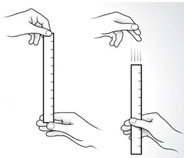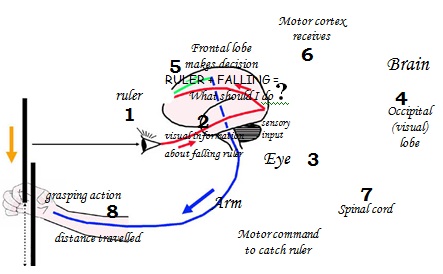Assignment:
1. Get a 30 cm ruler.
2. One person holds the ruler near the 30 cm mark and lets it hang vertically. The other person places their thumb and index finger about 4 cm apart on either side of the 0 cm mark, ready to catch it when it falls (their fingers should NOT touch the ruler).
3. Without warning the person holding the ruler lets go and the subject tries to catch the ruler as soon as possible. [Hint: to prevent guessing, vary the time before letting go of the ruler.]

4. Do 5 practice runs without recording the results.
5. Now record the results (in Table 1 on the next page) for 5additional trials of the same experiment. The level (in cm) just above the subject's first finger where the ruler was caught is recorded in Table 1 (use the first column marked standard 4 cm).
6. Repeat the experiment holding your fingers 10 cm apart. Record your results in the appropriate column.
7. Repeat the experiment with fingers 4 cm apart while saying every other letter of the alphabet as you wait for the ruler to drop. Record your results in the appropriate column.
8. Now repeat the experiment (4 cm apart) with the following twist: only catch the ruler when your partner says the key word "monkey." Be sure to say the word just before dropping the ruler. Your partner should try to trick you by occasionally dropping the ruler just after saying other, incorrect, words. For instance, if the experimenter says "banana" and then drops the ruler, don't catch it! Keep trying until you catch the ruler 5 times in a row on the correct word WITHOUT any mistaken catches on the wrong word. Record your results in the appropriate column.
9. Identify a new question you could test with this experiment (after changing one of the variables):
Question:
10. Write down your hypothesis for how you expect your reaction time to change with this new variable, compared to the variables that have already been tested.
Hypothesis:
11. Repeat the experiment (4 cm apart) with this new variation. Record the length at which the ruler was caught for those 5 times under the "Your Choice" column in Table 1.
Table 1: Results of reaction ruler drop trials
|
|
Standard
(4 cm)
|
Standard
(10 cm)
|
Alphabet
(4 cm)
|
Key Word
(4 cm)
|
Your Choice
(4 cm)
|
|
Trial 1
|
cm
|
cm
|
cm
|
cm
|
cm
|
|
Trial 2
|
cm
|
cm
|
cm
|
cm
|
cm
|
|
Trial 3
|
cm
|
cm
|
cm
|
cm
|
cm
|
|
Trial 4
|
cm
|
cm
|
cm
|
cm
|
cm
|
|
Trial 5
|
cm
|
cm
|
cm
|
cm
|
cm
|
|
Meancatch distance
|
cm
|
cm
|
cm
|
cm
|
cm
|
|
Mean reaction time*
|
ms
|
ms
|
ms
|
ms
|
ms
|
We'll work out your mean reaction time results in a minute, but first - here comes the science!
The Science Of Catching The Ruler
The experiment tests how long it takes the brain to translate visual information (falling ruler) into your voluntary (or conscious) motor commands and actions (grasping finger movements) that lead to the ruler being caught. The shorter the time, the faster your reactions.....that's if you were paying attention in the first place! Indeed practice specifically affects the "associative centers" in the brain, so that you can respond faster to what's happening in your visual world. The flow of information along the ‘visual' and ‘motor' nerve pathways is relatively constant even with lots of practice. It all comes down to attention

From the table below, the ‘mean catch distance' on the ruler can be converted into a ‘mean reaction time' in milliseconds (ms). Note: 1 millisecond is one thousandth of a second.
CATCH DISTANCE - REACTION TIME CONVERSION TABLE
|
Catch distance (cm)
|
Reaction time (ms)
|
Catch distance (cm)
|
Reaction time (ms)
|
|
1
|
50
|
16
|
180
|
|
2
|
60
|
17
|
190
|
|
3
|
70
|
18
|
190
|
|
4
|
80
|
19
|
200
|
|
5
|
90
|
20
|
200
|
|
6
|
100
|
21
|
210
|
|
7
|
120
|
22
|
210
|
|
8
|
130
|
23
|
220
|
|
9
|
140
|
24
|
220
|
|
10
|
140
|
25
|
230
|
|
11
|
150
|
26
|
230
|
|
12
|
160
|
27
|
230
|
|
13
|
160
|
28
|
240
|
|
14
|
170
|
29
|
240
|
|
15
|
170
|
30
|
250
|
REACTION TIME RATING
Reaction time Rating Comment
(milliseconds)
0-50 Ultra-fast A clairvoyant catcher... are you cheating?!?
50-130 Superb Impressive, do you play computer games?
131-175 Excellent Well done, are you a lightning fast texter?
176-200 Good Keep trying, you're not top gun yet!
201-240 Average Not bad - but you're just Joe Average.
241-250 Fair You'd get faster if it were money instead of a ruler!
251+ Slow ...ouch! Did the ruler hit your foot? Keep trying!
Remember...Milliseconds are one thousandth of a second. This means that:
One second (s) = 1000 milliseconds (ms)
Half of a second (0.5s) = 500 ms
A quarter of a second (0.25s) = 250 ms
One tenth of a second (0.1s) = 100 ms
Questions
Question 1: Is there a difference in the calculated reaction time between the 4 cm and the 10 cm trials? Which one seems to be faster? Why do you think this is?
Question 2: Did your reaction time increase or decrease while you were saying the alphabet? Explain why you think this happens.
Question 3: Did your reaction time increase or decrease when you had to listen for the key word? Explain why you think this happens.
Question 4: Based on your reaction time results for the alphabet and key word trials, do you think that laws requiring hands-free cellphone use in moving vehicles goes far enough in prevented distracted driving? Explain why you feel this way.
Question 5: Did your reaction time increase or decrease with the "Your Choice" experiment? Explain why you think this happens.
Question 6: How do you think the speed of your reaction to catch a ruler would compare to your REFLEX after touching a hot surface? What makes it possible for one of these responses to be faster than the other?
Attachment:- Endocrine Ed Online Interactive wroksheet.rar